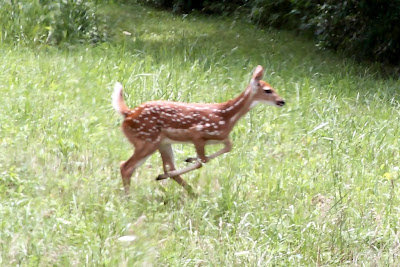
We share our local area with numerous whitetail deer. We see them every day. After taking up residence and walking around the property a lot, I often wondered why I didn't see more shed antlers. The bucks lose them every spring, they're hard and bonelike and don't decay easily, they turn white fairly quickly if exposed to the sun and thus pretty easily spotted. It's kind of like thinking too long about the question of why the earth has not (according to at least some people) been visited by aliens (the
Fermi Paradox). You end up asking "Where are they?"
The short answers are that sheds do decay in the sun, and, more importantly, they are a source of calcium, phosphorus and other minerals for squirrels, porcupines, and other small mammals. Still, how much effect could a few small animals have on these bony appendages?
Well, as it turned out, seeing (and hearing) is believing! We left a found shed on the picnic table about 100 feet behind the house, and one day I heard a strange scrunch, scrunch, scrunch. There was the answer: a fox squirrel (
Sciurus niger) gnawing away at the old antler. The squirrels sometimes work at it for five to ten minutes before, apparently, getting their minimum daily requirement and running off.
Shed antler hunting has become quite an activity, too. There are features that make antlers more (for example, a matched pair) or less (bleached, chalky, chewed) valuable, and hunters are familiar with
Boone and Crockett scoring. A recent innovation in the "sport" is the use of specially trained "
antler dogs"!
So while I enjoy finding the occasional shed antler while walking around the park or property, I also enjoy watching the squirrel demonstrating the maxim that nature makes use of, or recycles everything.
 There are several hummingbirds that regularly visit the flowering plants and our feeder. Then there is this guy, Hemaris diffinis, which as far as we can tell (not being lepidopterists), goes by a number of common names including snowberry clearwing, or more generically, hummingbird moth, bumblebee moth, hawk moth, sphinx moth (family Sphingidae), etc. Although somewhat smaller, they do resemble the hummingbirds by their movements, their ability to hover and that they are always beating their wings, even when feeding. Their long proboscis can be easily seen in these two images, extended into the flowers of the butterfly-bush (Buddleja davidii).
There are several hummingbirds that regularly visit the flowering plants and our feeder. Then there is this guy, Hemaris diffinis, which as far as we can tell (not being lepidopterists), goes by a number of common names including snowberry clearwing, or more generically, hummingbird moth, bumblebee moth, hawk moth, sphinx moth (family Sphingidae), etc. Although somewhat smaller, they do resemble the hummingbirds by their movements, their ability to hover and that they are always beating their wings, even when feeding. Their long proboscis can be easily seen in these two images, extended into the flowers of the butterfly-bush (Buddleja davidii).














 We have had so much rain lately that mushrooms are sprouting all over the place. I have tried to identify some but have had little luck. To identify a mushroom one must notice several things: the color of its spores, odor, surface texture, gills, shape of cap, certain characteristics of the stalk (if one is present). Some people make spore prints, some even examine certain features under the microscope. If I were going to eat these mushrooms, I certainly would want to make a definite identification, but I will not eat
We have had so much rain lately that mushrooms are sprouting all over the place. I have tried to identify some but have had little luck. To identify a mushroom one must notice several things: the color of its spores, odor, surface texture, gills, shape of cap, certain characteristics of the stalk (if one is present). Some people make spore prints, some even examine certain features under the microscope. If I were going to eat these mushrooms, I certainly would want to make a definite identification, but I will not eat 







